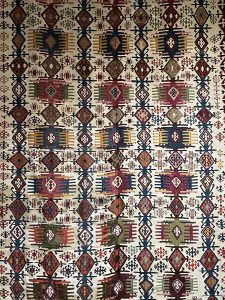The name over the door could hardly be clearer. Vakıflar Genel Müdürlüğü Vakıf Eserleri Müzesi, it says. The trouble is that no non-Turkish-speaker could possibly be expected to make sense of this. Which is a great shame because what lies behind the door of what was originally built as a school is in effect Turkey’s best carpet museum. Here, spread over two floors, can be found many of the thousands of carpets and kilims removed from the country’s mosques as their floors were carpeted over, obviating the need for individual rugs for people to pray on.
I take this up with Selman Kardeşlik, the director of the museum, and he points out, quite reasonably, that the museum is about much more than just carpets. There is calligraphy here, for example, and there is woodwork including some magnificent pieces from remote Divriği. “Look at this Selçuk-era candlestick,” he says. “We only recently discovered it in the depot as it had been wrongly labelled as Ottoman. It’s been damaged by fire but is still wonderful.”
He’s right, of course, and there’s no ignoring the fine grandfather clocks either, including one retrieved from the Kaleiçi Cami in Kuşadası, a town rarely mentioned in the same breath as history. We discuss, too, the twin covers for the Ka’aba embossed with gold embroidery that were stolen from the Damat İbrahim Paşa Cami in Nevşehir in 2003. Fortunately a London antique dealer had the sense to check with the Topkapı Sarayı before selling them on. In 2004 they were returned to Turkey. Alas, not to Nevşehir but at least here their future should be secure.
 Most of the carpets hang on the walls or can be viewed on sliding panels or under glass in the floor, but what really strikes me is how many of them have come from a small group of mosques, not all of them exactly household names. There are an astonishing number from the lovely ‘forest mosque’ at Sivrihisar but also many from the Sare Hatun Cami in Harput and from the Ulu Cami in Tarsus. Even more surprising are the large number of spectacular kilims that once belonged to the Ulu Cami in Uluborlu. Who’d have guessed? Must pencil in a visit.
Most of the carpets hang on the walls or can be viewed on sliding panels or under glass in the floor, but what really strikes me is how many of them have come from a small group of mosques, not all of them exactly household names. There are an astonishing number from the lovely ‘forest mosque’ at Sivrihisar but also many from the Sare Hatun Cami in Harput and from the Ulu Cami in Tarsus. Even more surprising are the large number of spectacular kilims that once belonged to the Ulu Cami in Uluborlu. Who’d have guessed? Must pencil in a visit.
But back we come to that vexing name. Vakıflar means something like Pious Foundations, which even in translation goes down with a clunk. Endowment perhaps? Charity even? But none of these words quite sums up the sheer power of the Vakıflar which owns almost all religious property in the country. So – General Management of the Pious Foundations Charity Items Museum? Hardly memorable – or even meaningful to a foreign visitor – is it?
We settle instead on Turkish and Islamic Arts Museum. That would cover everything nicely while suggesting to that foreigner why they might want to venture inside.
While we’re at it I ask about the fate of the Carpet Museum opened so expensively some years ago in the Imaret of what is once again the Ayasofya Cami in İstanbul. Selman Bey had worked there for some years. ‘Some of the most important items will be put on display in a Süleymaniye Museum near the Library later this year,’ he tells me.
And the building itself? It will go back to its original purpose as an imaret, or soup kitchen apparently. Best not to think of all the money squandered on turning it into a museum such a short time ago.
Written: 8 March 2024


